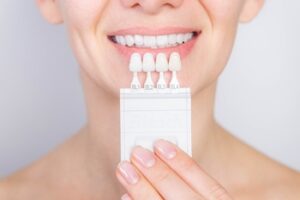Dental veneers have become popular for achieving a radiant smile, masking imperfections, and boosting confidence. However, when it comes to maintaining the brightness of veneers, a common question arises: Can you whiten veneers?
In this comprehensive guide, we’ll delve into the nuances of veneer care, focusing on the differentiation between porcelain and composite veneers. Understanding the factors influencing their colour and the right strategies to preserve their appearance is vital for a long-lasting, beautiful smile.
Porcelain Vs. Composite Veneers: The Staining Dilemma
 When contemplating veneer care, it’s crucial to recognise the fundamental distinction between porcelain and composite veneers. Unlike natural teeth, veneers, especially porcelain ones, don’t whiten through traditional teeth whitening methods. Porcelain veneers are stain-resistant and maintain their colour over time, providing a lasting solution for a bright, white smile.
When contemplating veneer care, it’s crucial to recognise the fundamental distinction between porcelain and composite veneers. Unlike natural teeth, veneers, especially porcelain ones, don’t whiten through traditional teeth whitening methods. Porcelain veneers are stain-resistant and maintain their colour over time, providing a lasting solution for a bright, white smile.
On the other hand, composite veneers, crafted from a combination of resin materials, are more susceptible to staining. This leads us to the question: Why do composite veneers stain? The porous nature of the composite resin material makes it prone to absorbing pigments from various sources, such as food, drinks, and smoking.
To ensure the longevity of your veneers, it’s vital to understand the unique characteristics of each type and tailor your maintenance routine accordingly.
Why Do Composite Veneers Stain?
The susceptibility of composite veneers to discolouration can be attributed to the composition of the material. Composite resin, while durable and versatile, tends to absorb pigments from external sources, just like your natural tooth enamel. This makes it crucial for individuals with composite veneers to be mindful of their dietary choices and lifestyle habits to prevent surface stains.
 Poor Dental Hygiene
Poor Dental Hygiene
Inadequate dental hygiene can accumulate plaque and surface stains on veneers. Maintaining consistent brushing, flossing, and expert cleanings is essential to avoiding these problems.
Consuming Stain-Inducing Substances
Foods and drinks with intense colour pigments, such as red wine, coffee, and certain berries, can contribute to staining. Reducing the use of these substances can help maintain the aesthetics of the composite veneers.
Tobacco Use
The colour of composite veneers can be greatly impacted by smoking or using tobacco products. Reducing or giving up tobacco usage has several health benefits, including that it helps keep veneers brighter.
Age And Wear
Over time, the resin material of composite veneers may wear down, making them more susceptible to staining. Frequent dental check-ups can aid in the early detection and fast resolution of problems.
Types Of Composite Resin Veneers: Understanding Staining Risks
There are two primary types of composite veneers: direct composite veneers and indirect composite veneers. Understanding the characteristics of each type is crucial in evaluating their susceptibility to staining and implementing effective maintenance strategies.
- Direct Composite Veneers
- Description: These veneers are applied to the teeth in a dental appointment.
- Material: Crafted from a composite resin material, typically a blend of plastic and glass.
- Staining Risks: Direct composite veneers may be more susceptible to staining than their indirect counterparts due to the porous nature of the resin material. They can absorb pigments from various sources, leading to surface discolouration over time.
- Indirect Composite Veneers
- Description: Indirect composite veneers are fabricated outside the mouth, usually in a dental laboratory, and later bonded to the teeth.
- Material: Similar to direct composite veneers, they are made from a composite resin material.
- Staining Risks: While still composed of composite resin, indirect veneers may have a smoother and more polished surface than direct ones. This characteristic can make them less prone to staining, as the smoother surface is less likely to trap pigments.
Understanding the nuances of each type of composite veneer and implementing these maintenance strategies can go a long way towards preserving the colour and aesthetics of your smile.
Maintaining Your Composite Veneers: A Stain-Prevention Guide
Preserving the vibrancy of your composite veneers involves a combination of mindful practices and regular dental care. Here’s a guide to help you maintain your veneers and prevent surface stains:
Brush Your Teeth Regularly
Adopting a diligent oral hygiene routine is paramount. To protect the veneer surface, brush your teeth at least twice a day using non-abrasive toothpaste with soft bristles.
Choose The Right Toothpaste
Opt for toothpaste designed for veneers or sensitive teeth. Harsh abrasives can compromise the integrity of the veneer surface.
Avoid Stain-Inducing Substances
Minimise the consumption of foods and drinks known to cause stains. If you indulge, rinse your mouth with water afterwards to mitigate the impact.
Quit Smoking
Besides the myriad health benefits, quitting smoking or tobacco use can significantly enhance the lifespan and appearance of composite veneers.
Regular Professional Cleanings
Schedule regular professional cleanings with your dental professional. This ensures the removal of plaque and surface stains that may accumulate over time.
Use Mouthwash
Incorporate a non-alcoholic, fluoride-based mouthwash into your daily routine to help maintain good oral health and minimise staining.
Frequently Asked Questions
 Can you whiten a dental veneer at home?
Can you whiten a dental veneer at home?
While natural teeth can be whitened at home, the same approach doesn’t apply to veneers. Porcelain veneers resist traditional teeth-whitening methods, and attempting to whiten teeth at home—when veneered—may lead to unintended consequences. It’s advisable to consult your dentist for professional advice on maintaining the colour of your veneers.
How often should I have professional cleanings for my veneers?
Regular professional cleanings are crucial for maintaining the longevity of your veneers. It’s generally recommended to schedule dental cleanings every six months. Your dental professional will assess the condition of your veneers, remove any surface stains, and address any concerns during these appointments.
Can composite veneers be polished to remove stains?
Yes, dental professionals can polish composite veneers to remove surface stains. However, this should only be done by a qualified dentist during a regular check-up or professional cleaning. Attempting to polish veneers at home can lead to damage, and it’s always best to seek professional assistance.
Are veneers a permanent solution?
Veneers are a durable but temporary fix. They can endure for 10 to 15 years on average. Oral hygiene, dietary habits, and general wear and tear can influence their lifespan. Regular consultations with your dentist will help assess when replacement may be necessary.
Nurturing Your Radiant Smile
 Maintaining the brightness and vibrancy of your veneers involves a thoughtful combination of proper care, regular dental check-ups, and mindful lifestyle choices. Understanding the distinctions between porcelain and composite veneers and the factors influencing staining empowers you to make informed decisions for your oral health.
Maintaining the brightness and vibrancy of your veneers involves a thoughtful combination of proper care, regular dental check-ups, and mindful lifestyle choices. Understanding the distinctions between porcelain and composite veneers and the factors influencing staining empowers you to make informed decisions for your oral health.
Whether you have opted for stain-resistant porcelain veneers or versatile composite veneers, embracing good oral hygiene practices and being mindful of your diet contribute significantly to the longevity of your dazzling smile.
Remember, veneers, though durable, are not invincible. Regular dental check-ups, professional cleanings, and promptly addressing any concerns with your dentist are integral to ensuring your veneers stand the test of time.
By adopting these practices and following the guidelines outlined in this comprehensive guide, you are preserving the beauty of your veneers and nurturing the overall health of your teeth and gums.
Contact Dental 266, Burwood, NSW, 2134, today at (02) 9051 0600 to learn more about your cosmetic veneers.
Sources
Colgate. “Porcelain or Composite Veneers: Which Are Better?” Colgate, 16 Oct. 2021, www.colgate.com/en-us/oral-health/veneers/composite-veneers-other-options.
Fahl, Newton, and André V. Ritter. “Composite Veneers: The Direct–indirect Technique Revisited.” Journal of Esthetic and Restorative Dentistry, vol. 33, no. 1, Dec. 2020, pp. 7–19. https://doi.org/10.1111/jerd.12696.
“How to Brush Teeth Properly?” Oral-B, www.oralb.co.uk/en-gb/oral-health/why-oral-b/electric-toothbrushes/how-to-brush-teeth-properly.
Kamble, Vaibhav D., and Rambhau D. Parkhedkar. “Esthetic Rehabilitation of Discolored Anterior Teeth With Porcelain Veneers.” Contemporary Clinical Dentistry, vol. 4, no. 1, Jan. 2013, p. 124. https://doi.org/10.4103/0976-237x.111635.
Shaw, Neil. “You Can Now Get Whitening Toothpaste for Veneers.” Wales Online, 23 Nov. 2023, www.walesonline.co.uk/whats-on/shopping/you-can-now-whitening-toothpaste-28159304.
Soliman, Ingy S., et al. “Effect of Electronic Cigarettes Smoking on Color Stability of Lithium Disilicate Glass Ceramic Veneers.” Egyptian Dental Journal, vol. 69, no. 3, July 2023, pp. 2019–27. https://doi.org/10.21608/edj.2023.196292.2462.

